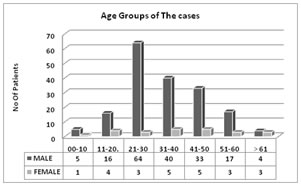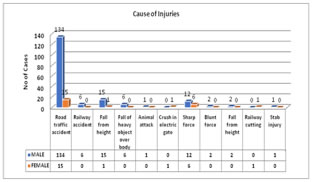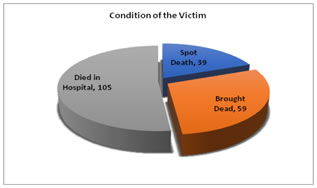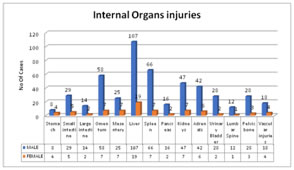Official Journals By StatPerson Publication
|
Table of Content - Volume 8 Issue 3 - December 2018
A profile of abdomino-pelvic injuries in medico-legal autopsies
Sarah Al Hinnawi1, Yadav G More2, Dinesh S Akarte3*, A A Mukherjee4
1Resident Doctor, 2Resident Doctor, 3Assistant Professor, 4Professor and Head, Department of Forensic Medicine and Toxicology, Government Medical College, Nagpur Maharashtra INDIA. Email: hannawi50@gmail.com
Abstract Background: Due to rapid industrialization and motorization of the modern world there is a rapid increase in the incidences of accidental injuries. WHO advisory group in 1956 defined accidents as “an unpremeditated event resulting in recognizable damage”. Injuries following accidents especially after road traffic accidents is one of the common causes of morbidity and mortality. More over these incidences involve relatively younger population of the society. Since time immemorial the thoraco-abdominal cavity has been looked upon as one of the most vulnerable part of the body and injuries involving it have been the topic of interest amongst forensic experts. Due to its anatomical position, relatively unprotected anterior abdominal wall and large surface area, thoraco-abdominal region is major site of impact in any form of blunt trauma particularly motor vehicular accidents. Thoraco-abdominal injuries can be caused by a wide range of causes including but not limited to road traffic accidents, fall from height, railway accidents, industrial accidents, and assault. We conducted this study to analyse the pattern of abdomino-pelvic injuries in cases brought for medicolegal autopsies in the department of forensic medicine of a tertiary care medical college situated in Central India. Materials and Methods: This was a prospective study in which 203 cases brought for medicolegal autopsies and having abdomino-pelvic injuries were included depending upon a predefined inclusion and exclusion criteria. Routine information about age, sex, brief history/ facts about the cases was collected from police inquest report, relatives and friends of the deceased. In all cases, detailed post-mortem examinations were carried out. This included full external and internal examination of the victim’s body, noting the presence of any associated body injuries and finding the cause of death in every case. The data was analyzed using SSPE 22 Software. P value less than 0.005 was taken as statistically significant. Results: Out of 203 studied cases there were 179 (88.18%) males and 24 (11.82%) females with a M: F ratio of 1:0.13. The most common affected age group was found to be 21-20 yrs. (33.01%) and the most common manner of injury was accidents (88.18%). Road traffic accidents were the predominant cause of injuries (73.40%) and majority of the patients were admitted to hospital and subsequently died (51.73%). In majority of the cases survival period was found to be 2-6 hours (23.65%). External abdominal and pelvic injuries were present in 62.07 % and 34.98%patients respectively and the most common type of external injury was found to be contusion which was present in 53 (26.11%) and 27 (13.30%) patients in abdominal and pelvic regions respectively. The most common visceral injuries were found to be involving liver (62.07%) followed by spleen (35.96%) and omentum (32.02%). In 94 (46.31%) cases associated head, chest and limb injuries were present. Conclusion: Abomino-Pelvic injuries constitute a major cause of morbidity and mortality in today’s motorized and mechanized world. The fact that majority of our cases were admitted in hospital before their eventual deaths points towards the fact that proper knowledge, early diagnosis and prompt management of these injuries may prove to be lifesaving for patients of abdomino-pelvic injuries. Key Word: Medico-legal Autopsies, Abdomino-Pelvic Injuries, Road Traffic Accidents, Visceral injuries.
INTRODUCTION With increasing urbanization and motorization, penetrating and non-penetrating injuries of the abdomen and pelvis are becoming increasingly common and many cases they prove to be fatal1. The abdomen is the third commonest region of the body that is injured in civilian trauma, as human abdomen is largely unprotected by the bony structure. Injuries to the abdomen are important as it contains numerous vital organs like liver, spleen, kidney, pancreas and hollow viscous like stomach, intestines and urinary bladder and injuries to these organs are significant as isolated injuries to liver, spleen, and intestine can be saved if timely surgical aid is provided to them2. Among all accidental deaths, road traffic injuries claim 1.2 million lives every year and form the main bulk of deaths from non-natural causes3. More than 25% of global accidental deaths occur in South East Asia region4. It is estimated that by the year 2020, injuries from road traffic accidents will be the third most common cause of disability worldwide and the second most common cause in the developing world5. The underlying mechanisms for injury to intra-abdominal organs are compression and deceleration6. The former occurs because of the direct blow, such as a kick or punch, or compression against a rigid object such as steering wheel. Penetrating injuries to abdomen and pelvis are caused by firearms and stab injuries. In our country, stab injuries are more common than bullet injuries and involved organs are usually the vital areas, e.g., precordial region or abdomen. The firearm injuries cause far more associated injuries which accentuate the mortality8.Injuries to the abdomen and pelvis are not always isolated but often associated with injuries to other parts, e.g., head, chest, spine, extremities etc9. Early recognition of the injury and immediate treatment are mandatory in saving the lives of many of these patients10. This study was undertaken with the aim to describe the pattern of abdomino-pelvic injuries in trauma cases and to establish the relationship between the extent, nature and type of abdomino-pelvic injuries and other injuries to fatality, survival period, age, sex, socioeconomic status, type of trauma involved and the pattern of injuries from the autopsy findings to widen the knowledge of the medical faculty in the field of early diagnosis and management of such injuries. Post-mortem study of abdomen and pelvis injuries will be helpful in instituting proper preventive measures according to clinical priority and will help in ensuring survival of patient and to draw public attention and awareness towards road traffic accidents and to formulate road safety measures towards strategic planning in the prevention and control of road traffic accidents.
MATERIALS AND METHODS This was a descriptive study of autopsies having abdomino-pelvic injuries conducted in the Department of Forensic Medicine, Government Medical College, Nagpur after approval from the institutional ethics committee. The study consisted of total of 203 cases of abdomino-pelvic injuries including the deceased who had died on spot, dead on arrival and died after hospitalization. The information about age, sex, socioeconomic status of the deceased, brief history/ facts about the cases were collected from police inquest report, relatives and friends of the deceased. In admitted cases, information was collected from hospital records and death summaries. In all cases, detailed post-mortem examinations were carried out. In all cases examination was done as per institutional protocol and is as follow. External Examination: The condition of the body, specific site and dimensions of the injuries correspondingly present in the six regions of the body, i.e., head and face, neck, chest, abdomen and pelvis and extremities were recorded Internal Examination: Detailed internal examination of all the three principal body cavities, e.g., cranial, thoracic and abdomino-pelvic cavities was carried out and findings were recorded. The location and extent of all abdominal and pelvic organs injured were noted in detail to find out any definite pattern in that region. Associated Injuries: Findings regarding the presence of any associated body injuries in the neck, chest, spinal column, extremities and head of the victim with abdomen and/or pelvic trauma was noted down in the standard proforma. Cause of Death The cause of death in each case was recorded in the standard proforma. It was either hemorrhage and shock alone or hemorrhage and shock in combination with cranio-cerebral damage or cerebral damage or spinal cord laceration, etc. Inclusion Criteria All claimed, non-decomposed bodies brought for medico-legal autopsy with an injury to abdomen or pelvis or both irrespective of involvement of other body regions with or without external injuries with proper history of abdomino-pelvic injuries confirmed by police relative and friends.
RESULTS In this study of abdomino-pelvic injuries in medicolegal autopsies a total of 203 cases were studied. Out of 203 cases there were 179 males (88.18%) and 24 females (11.82%) with a M: F ratio of 1: 0.13. The analysis of age groups of the cases showed that the most common age group to be affected was between 21-30 years (33.01%) followed by 31-40 years (22.17 %) and 41-50 years (18.72%). Least commonly affected age group was found to be between 0-10 years (2.95%). Figure 1: Gender and Age Distribution of the victims The analysis of the cases based on socioeconomic status showed that the maximum numbers of victims were from the lower socio- economic status, i.e., 57.64% of the total cases. Next in the frequency were the cases from middle socioeconomic status 33.99% followed by the cases of upper socioeconomic status 8.37%.
Table 1: Socioeconomic Status Of The Studied Cases
The analysis of the cases based on the factors such as place of incidence, time of incidence, manner of incidence and survival period showed that majority of the incidences took place in rural areas (57.64%) followed by urban areas (42.36%). In the present study, most of the incidence of abdomino-pelvic injuries occurred between 12:01 to 18:00 hours i.e., 33.49%, followed by 18:01 to 24:00 hours i.e., 32.02%. Thus, almost 65% incidence occurred between 12 noon to 12 midnight. Less number of incidences occur in 06:01 to 12:00 hours i.e., 23.65% and least number of cases were noticed between 00:01 to 06:00 hours i.e., 10.84%. Maximum numbers of cases, 88.18% were accidental in nature, followed by homicidal (9.85%), and with least numbers were suicidal in nature (1.97%). It varies from spot death to 28 days. Out of total cases, 19.21% of the victims died on spot, 18.23% were survived for less than 2 hours while 23.65% of victims survived for 2-6 hours after the incidence.
Table 2: Place, Time, Manner and Survival Period after the incidence
In this study maximum number of cases was accidental in nature in which most of the cases were road traffic accidents (73.40%), next was fall from height (7.88%). In homicidal cases, 8.87% cases were stab injuries (sharp force) and 0.98% was due to blunt force. In suicidal cases, 0.98% cases fell from height.
Figure 2: Cause of injuries in the affected cases
The victims died on the spot in 19.21% cases and were brought dead to the hospital in 29.06% cases. Thus, about 48.27% victims of abdomino-pelvic injuries died before reaching the hospital for treatment. Of the remaining victims, 51.73% died after being admitted to the hospital.
Figure 3: Condition of the victim after the incidence.
The study of presence of external injuries showed that external injuries in abdominal region were present in 62.07% and absent in 37.93% cases. In pelvic region, external injuries were present in 34.98% and absent in 65.02% of total cases. Table 3: External Abdomino-Pelvic injuries in victims
It was observed that contusion was seen in 26.11% cases followed by abrasion in 17.24% cases and stab injury in 8.37% cases in the abdominal region. In pelvic region, contusion was seen in 13.30% cases, laceration and abrasion was seen in 6.40% and 5.91% cases. Contusion was found to be the most common type of external injury in abdominal (26.11%) as well as in pelvic (13.30%) regions.
Table 4: Distribution of Types of the External Injuries in Abdomino-Pelvic Injuries
The analysis of involvement of internal organs in abdomino-pelvic injuries showed that liver was involved in the majority of cases (62.07%) followed by spleen (35.96%),omentum (32.02%),kidneys (26.60%), adrenals (23.64%), pelvic bone (15.27%) and urinary bladder (14.78%).
Figure 4: Internal Organs Injuries in the victims.
Finally, the distribution of associated injuries to another body region in abdomino-pelvic injuries showed that plain abdomino-pelvic injuries were found in 17.73% of total cases whereas associated injuries of two or more than two body regions were found in the majority of cases (46.31%).
Table 5: Distribution of types of the external injuries in abdomino-pelvic injuries
DISCUSSION The present study was undertaken to discuss the pattern of abdominal and pelvic injuries in relation to various factors in the Central Indian Population. A total number of 203 brought for medico-legal autopsy having injuries to abdomen, pelvis or both were studied during the study period. In our study there was a male predominance with a M: F ratio of 1: 0.13. The most common age group to be affected was found to be between 21-30 years (33.01%) followed by 31-40 years (22.17 %). Lower socio-economic class of people constituted a maximum number of cases, that is, 57.64%, followed by the middle class (33.99%). Given that majority of the victims had injuries following accidents male preponderance was expected. In a large study of 1888 medicolegal autopsies conducted by Bordoni PHC11 et al, the authors found that most of the individuals were male, brown-skinned, single and occupationally active. The median age was 34 years. The abdominal organs most injured in the penetrating trauma were the liver and the intestines, and in blunt trauma, the liver and the spleen. Homicide was the most prevalent circumstance of death, followed by traffic accidents, and almost half of the cases were referred to the Forensic Medicine Institute by a health unit. Similar male preponderance was found in the studies conducted by Subedi N et al12 (80% males) and Buschmann CT et al13 (male: female ratio of 3.75:1). In this study maximum number of cases, 88.18% were accidental in nature, followed by homicidal (9.85%), and with least numbers were suicidal in nature (1.97%). Many studies have reported the most common cause of accidents to be due to motor vehicular accidents. In a study of 300 trauma cases conducted by King et al14 the authors found that injuries were most frequently from motor vehicle accidents (46%). Abdominal injuries were found in 30% of the cases. The liver was injured in 40.24% followed by spleen in 30.43%. Kidney and adrenals were injured in 16.46% whereas stomach was injured in 2.52% cases. Small and large intestines were injured in 6.64%. Similarly, road traffic accidents were found to be the most common cause of injuries in the studies conducted by C.L. Ong et al15 and O. P. Sharma16 et al. In our study it was found that most patients survived for 2-6 hours (23.65%) following accidents while died on the spot (19.21%) before any kind of medical assistance could be provided to them. Similar findings were reported by the authors Srivastava et al17 who observed that half the number of victims i.e. 51.73% died on the spot or within 6 hours of the accident, 13.20% of the victims died within 6-12 hours while 20.5% of the cases died later 3 days. Meera et al18 reported a higher percentage of spot deaths (47.2%) as compared to our study. The analysis of external injuries showed that the most common injury in abdominal region (42.06%) as well as pelvic region (38.03%) was contusion followed by abrasion in abdominal region (27.78%) and abrasion (18.31%) and laceration (18.31%) in pelvic region. Similar injury patterns were reported by Shetty Set al19 who reported that contusions were the commonest (n=38) followed by abrasion (n=29), laceration (n=5). Internal abdominal injuries were observed in 153 cases. Kidney was the most commonly involved abdominal organ (n=33) in road traffic accidents followed by the liver (n=29). Liver (52.71%), spleen (32.51%) and omentum (28.57%) were found to be the most commonly injured organs in the studied cases. Similar visceral organ injury patterns were reported by Reddy N B et al20 in their study of 100 postmortem autopsies of road traffic accident found that the most commonly injured abdominal solid organ was liver 32.6%, followed by spleen 18.3% cases.
SUMMARY AND CONCLUSION The present study was undertaken to discuss the pattern of abdominal and pelvic injuries in the results of the present study are summarized as follows. Majority of the victims were male with male-female ratio 7.46:1. In abdomino-pelvic injuries with most common age group involved was 21-30 years(33.01%) followed by 31-40years (22.17%). Most of the cases of abdomino-pelvic injuries were accidental in nature (88.18%), very few were homicidal (9.85%) and suicidal (1.97%) in nature. The external injuries were present in 59.11%. The commonest type of external injury was contusion (40.24%), followed by abrasion (26.83%), laceration (12.19%) and stab wound (10.97%).The main organ involved was liver (62.07%) followed by spleen (35.96%) and kidney (26.60%). The main causative factor for these injuries was blunt trauma abdomen due to vehicular accidents.Isolated injury to the abdomino-pelvic region was found in 17.73% of total cases. Associated injuries of two or more than two body regions were found in the majority of cases (46.31%) with low survival rate.Abdomino-pelvic injuries are one of the commonest causes of accidental deaths in today’s industrialized society. In this study most of the victims survived for a period of 2-6 hours and were admitted in hospital before their eventual deaths. This fact is important because early diagnosis and prompt intervention may reduce mortality in these cases.
REFERENCES
|
|
||||||||||||||||||||||||||||||||||||||||||||||||||||||||||||||||||||||||||||||||||||||||||||||||||||||||||||||||||||||||||||||||||||||||||||||||||||||||||||||||||||||||||||||||||||||||||||||||||||||||||||||||||||||||||||||||||||||||||||||||||||||||||||||||||||||||||||||||||||||||||||||||||||||||||||||||||||
 Home
Home




